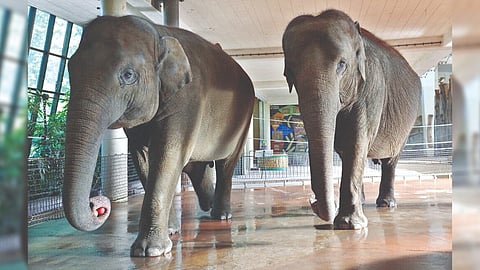

NEW YORK: An elephant’s trunk has 40,000 muscles and weighs more than a Burmese python. The appendage is strong enough to uproot a tree, yet sensitive enough to suction up fragile tortilla chips.
But how does an elephant’s brain help accomplish these feats of dexterity? That has been difficult to study, according to Michael Brecht, a neuroscientist at the Humboldt University of Berlin.
Weighing in excess of 10 pounds, the elephant’s brain degrades quickly after death and is a hassle to store. “I tend to think that the big animals are a bit neglected because we don’t do enough work on big brains,” Dr. Brecht said.
Dr. Brecht and his colleagues were fortunate enough to gain access to a trove of elephant brains from animals that had died of natural causes or were euthanised for health reasons and ended up either frozen or in a fixative substance at the Leibniz Institute for Zoo and Wildlife Research in Berlin.
In a study, Dr. Brecht and his colleagues reported that elephants had more facial neurons than any other land mammal, which might contribute to trunk dexterity and other anatomical abilities.
The study also helped to pinpoint major differences between the neural wirings of African savanna elephants and Asian elephants.
Using the brains of four Asian elephants and four African savanna elephants, the researchers homed in on the facial nucleus, a bundle of neurons concentrated in the brainstem and hooked up to facial nerves.
In mammals, these neurons serve as the control center for facial muscles. They’re in command whenever you wrinkle your nose, purse your lips or raise your eyebrows. They also help elephants employ their trunks.
The researchers divided the facial nucleus into regions of neurons that controlled the elephant’s ears, lips and trunk. African elephants sported 63,000 facial neurons, while their Asian cousins had 54,000. The only mammals with more are dolphins, which pack nearly 90,000 facial neurons into their sensitive snouts.
While his team expected both African savanna and Asian elephants to possess massive stores of facial neurons, Dr. Brecht said the discrepancy between the two species was noteworthy.
While the animals look similar, they have major facial differences. African elephants have much larger ears, which they fan out when they charge.
The researchers found a neurological correlation — African elephants devoted roughly 12,000 facial neurons to controlling just their ears.
This not only dwarfs the amount of neurons controlling Asian elephant ears, it is nearly 3,000 more neurons than are needed to operate the entire human face.
Another major difference is how each elephant wields its trunk, which requires nearly half of the elephant’s total facial neurons to operate.
African elephants utilise two finger-like projections on the tips of their trunks to pinch objects, like the motion made with a pair of chopsticks.
Asian elephants have only one finger-like projection and grasp objects by wrapping their trunks around them.
The researchers pinpointed two neural regions in African elephants that probably correlated to fine finger control at the tips of their trunks; those regions were less defined in Asian elephants.
Visit news.dtnext.in to explore our interactive epaper!
Download the DT Next app for more exciting features!
Click here for iOS
Click here for Android